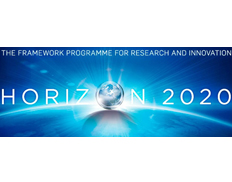Share
Print

07 February 2017 14:55
As of 1st January 2017, Switzerland is associated to the entire H2020 programme. In consequence, it is now also associated to this topic. In a nutshell this means that Swiss partners in a proposal are now on an equal footing with partners from EU Member States or other Associated Countries. For the details, please read this note.
The submission session is now available for: REV-INEQUAL-13-2017(RIA)
The call deadline was Thursday 2 of February 17 Pm 2017. A total of 26 proposals were submitted in response to this call. The number of proposals for this topic is shown below including the indicative budget of the topic:
REV-INEQUAL-13:RIA: 12 submitted (indicative budget: 2,5 M€)
07 February 2017 14:33
The submission session is now available for: REV-INEQUAL-13-2017(RIA)
The call deadline was Thursday 2 of February 17 Pm 2017. A total of 26 proposals were submitted in response to this call. The number of proposals for this topic is shown below including the indicative budget of the topic:
REV-INEQUAL-13:RIA: 12 submitted (indicative budget: 2,5 M€)
06 February 2017 14:31
The submission session is now available for: REV-INEQUAL-13-2017(RIA)
13 January 2017 11:49As from 1 January 2017 Switzerland is associated to the entire Horizon 2020. In practical terms this means that for all Horizon 2020 projects for which the GA is signed as from 1 January the Swiss participants are automatically eligible for funding and may count towards the minimum number of participants required for a project (see the eligibility criteria for funding and participation under Regulation 1290/2013 on Horizon 2020 Rules for participation).
For more information see:
http://ec.europa.eu/research/participants/data/ref/h2020/other/hi/h2020-hi-swiss-part_en.pdf
| Topic identifier: | REV-INEQUAL-13-2017 | ||
| Publication date: | 14 October 2015 | ||
| Types of action: | RIA Research and Innovation action | ||
| DeadlineModel: Planned opening date: |
single-stage 04 October 2016 |
Deadline: | 02 February 2017 17:00:00 |
| Time Zone : (Brussels time) | |||
The post-2014 inflow of refugees and asylum applicants can pose significant challenges to EU economies, societies and processes of integration. In the medium and long term, much will depend on how fast and well these new migrants will be integrated into European labour markets. International experience suggests that they have lower employment rates and lower wages than EU workers, but that these differences diminish over time as migrants improve their language skills and gain professional experience in the host country. At the same time, their successful labour market integration could also help alleviate the fiscal effects of negative demographic trends. Nonetheless, the situation of post-2014 refugees and asylum applicants is more complicated since they may face a number of specific barriers to accessing labour markets, including related to xenophobia and discrimination. These obstacles include the loss of identity documentation and education certificates, non-acceptance of qualifications or educational attainment, family separation, long periods of inactivity in the asylum system, lack of educational opportunities, geographical mobility restrictions and discrimination. Initial obstacles and failure to develop efficient integration policies, including at sectorial level, may ultimately lead to chronic underemployment and social exclusion. The specific aim is to examine the challenges and opportunities faced by refugees and asylum applicants in connection with their skills, qualifications, access to education, and employability. The goal is to estimate the economic and social impacts of the policies designed to improve the integration of migrants and to provide policy recommendations for facilitating integration.
Scope:Research to address this challenge should take stock of skills and qualifications of post-2014 migrants, including asylum seekers and refugees, with a view to estimate the potential for integration. Analysis should provide insights on the reasons behind rates of unemployment and inactivity of international migrants, including at local level. Comparisons with earlier cohorts from similar sending countries should be explored to estimate gaps and challenges, identify transferable practices, and provide better calibrated policy recommendations. Special attention should be given to facilitating the integration of women and young migrants in the labour market through access to education and training.
Research should also review policies which aim to facilitate the labour market integration of asylum seekers at sectorial level, taking into account sectorial shortages and needs. Comparative explorations (involving multiple Member States and, where relevant, third countries) should cover a wide range of interventions e.g. education and training, recognition of qualifications and skills, access to housing, migration-induced linguistic diversity and its consequences for society, removing legal restrictions to early labour market entry, language skills, active labour market policies, the effectiveness of wage subsidies and entrepreneurial incentives (including access to credit), tax and benefits schemes, and wage levels. In combination with the above, the analysis should also assess barriers to labour market integration specific to post-2014 international migrants and potential avenues for the EU in facilitating access to employment. Finally, the social and economic fallout from social exclusion of the recently arrived international migrants should be explored.
The Commission considers that proposals requesting a contribution from the EU in the order of EUR 2.5 million would allow this specific challenge to be addressed appropriately. This does not preclude submission and selection of proposals requesting other amounts.
Expected Impact:The analytical data sets on skills, qualifications and employability of post-2014 refugees and asylum applicants provided by this research action are meant to inform the design of policies and programmes that facilitate their labour market entry or further training. The identified best practices and benchmarks ought to allow for measuring the effectiveness of pro-active employment policies targeting the specified migrant cohorts across Europe.
Cross-cutting Priorities:Socio-economic science and humanities
Gender
International cooperation
